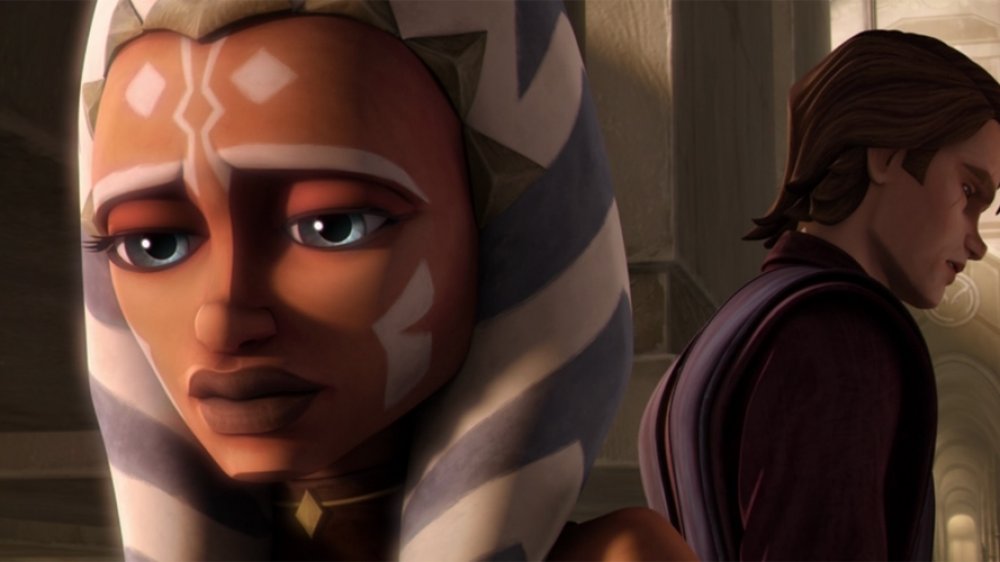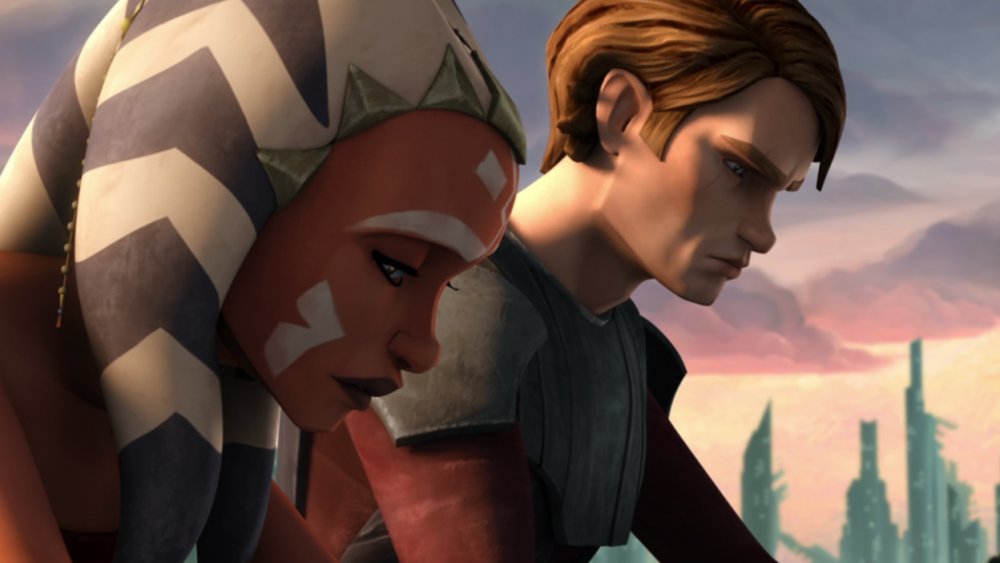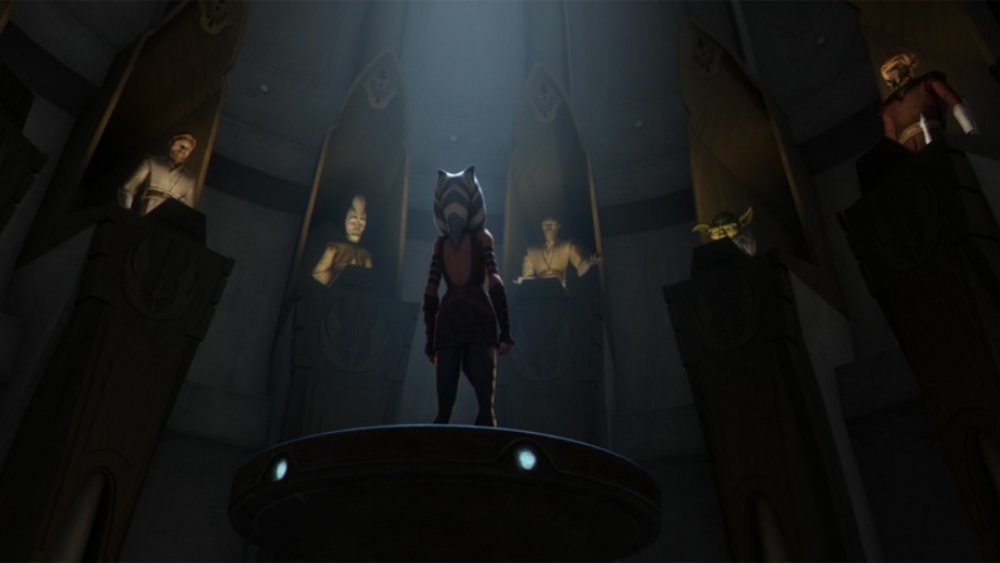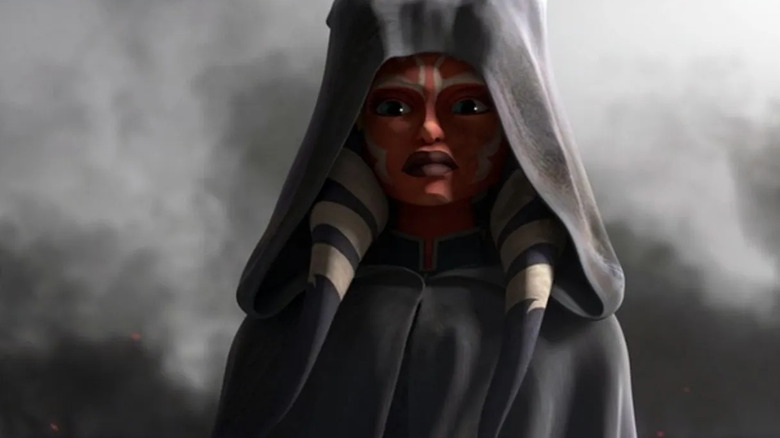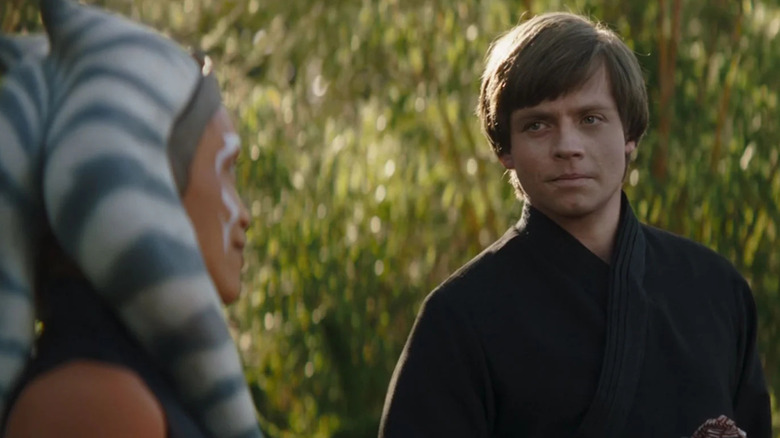Ahsoka Tano Facts Star Wars Fans Know About The Clone Wars Hero
If you've ever fallen down the endless rabbit hole that is the Expanded Universe, then you already know that there's a whole lot more to the "Star Wars" franchise than what moviegoers see on the big screen. Just look at Boba Fett! He's a fan-favorite character that people will tell you is the galaxy's most badass bounty hunter, but all he does on film is stand around and then get knocked into a pit by a guy who can't see. And that's just one example. The "Star Wars" novels, comics, and TV shows are full of great characters that have become fan favorites without ever getting a spotlight in the films.
The most prominent example of this in recent years is undoubtedly Ahsoka Tano. She's the onetime apprentice of Anakin Skywalker whose destiny takes her beyond the Jedi and the Sith. And as she's such a complex character, there's a whole lot to learn about this fascinating "Star Wars" figure. From her real-world inspiration to the way she avoided her original fate, here's the truth behind Ahsoka Tano.
Begun, this teaching job has
When you get right down to it, the job of a Jedi Knight is essentially half wandering samurai-peacekeeper and half substitute teacher-father figure to a teenager who just won't stop complaining. It's been that way ever since Luke Skywalker first wandered out to that old wizard Ben Kenobi's cave back in 1977, and by the time "The Phantom Menace" hit theaters over 20 years later, we started to get an idea of how all of this worked.
The basic idea is that after being certified by the intergalactic school board that is the Jedi Council, each Jedi Master takes on an apprentice of their own, passing down their knowledge and experience to the next generation. Ideally, this is done after the apprentice — called a "Padawan" — gets a basic education in the Force as a child, but in very rare circumstances, a hotheaded teenager joins up and then ruins everything and-slash-or saves the entire galaxy multiple times. Honestly, it's kind of a crap shoot. Either way, once the apprentice becomes a full-fledged Jedi Knight, they take on their own apprentice, and the cycle continues down through the ages.
We know all this because we see it happening in the prequel trilogy, in which Obi-Wan Kenobi goes from being an apprentice to Qui-Gon Jinn to a master in his own right who demands the opportunity to train Anakin Skywalker. The thing is, we also see Anakin himself graduate from Padawan to Knight in "Revenge of the Sith," signaled by the fact that he no longer has the galaxy's worst haircut. Of course, that raises the question: If Anakin didn't go straight from being Obi-Wan's student to being a genocidal cyborg fascist, did he have an apprentice of his own? It turns out he did, and she's one of the most interesting characters in "Star Wars" history.
Ashla and the Clone Wars
A long time ago — 2008, if you want to get specific about it — "Star Wars: The Clone Wars" was released in theaters as a lead-in to a television series of the same name on Cartoon Network. Set between "Attack of the Clones" and "Revenge of the Sith," the film followed Obi-Wan Kenobi and Anakin Skywalker as they attempted to rescue Jabba the Hutt's son, Rotta, during the eponymous conflict. When they got that assignment, Obi-Wan and Anakin, along with the audience, were introduced to Ahsoka Tano, who'd been assigned as Anakin's brand new Padawan.
Originally, however, the concept of "The Clone Wars" was very different, and so was Ahsoka. When the show was first in development, in fact, she wasn't even "Ahsoka" at all. The earliest concept from Dave Filoni – a veteran animator who would go on to be the supervising director, executive producer, and a writer on the series – was built on a very different idea. The focus was on a ragtag crew working on the fringes of the galaxy. The crew would've dealt with the sketchier side of the "Star Wars" universe, supporting the war effort by brokering deals with scoundrels and crime lords, far, far away from where Obi-Wan and Anakin were fighting alongside the clone troopers. The Jedi would've been represented, though, in the form of a master named Sendak and his young apprentice, Ashla.
Both Filoni and George Lucas wanted to have a prominent female Jedi in order to appeal to the girls in the audience, so when the series was retooled to be built around Obi-Wan and Anakin's time in the war, Ashla stuck around. Just like in Filoni's original pitch, she was the viewpoint character who, like the audience, was thrown into this legendary era when the galaxy was barreling toward tragedy. The only difference was that unlike Ashla herself, the audience already knew how Anakin's story would end, giving the "Clone Wars" series — and Ashla herself — a suspenseful tension that it would've otherwise lacked.
Ashla becomes Ahsoka Tano
"Star Wars" has never really been subtle about character names. "Vader," for example, literally means "father" in Dutch, and even if you can get past George Lucas naming his chosen one character "Luke S.," there's the fact that "Luke" is probably related to the Latin word for light. And those are the ones that require some work. A bad guy named "General Grievous?" An evil bounty hunter named "Cad Bane?" A loner named "Han Solo?" It's honestly amazing that Rey's last name didn't turn out to be "of Sunshine."
"Ashla" is at least a little different. In George Lucas' original notes for "The Star Wars," it was the proper name for the light side of the Force, and if you were the kind of fan who obsesses over the most minor details, you might've seen it elsewhere, too. While it's not spoken in the film, it's the canonical name of one of Yoda's "youngling" students briefly seen in "Attack of the Clones," who just happens to be a young Togruta who bears a suspicious resemblance to Anakin's future Padawan. It's possible that they were meant to be the same character, but in 2008, Leland Chee, the guy officially in charge of maintaining continuity for the saga, mentioned that they couldn't be the same because their ages didn't match up.
Whatever the reason, Lucas decided to rename the character during the production of "Clone Wars," and he looked to history for inspiration. Ashoka the Great was the emperor of India in the third century BCE, and the early part of his reign was marked by some truly incredible violence. According to legend, Ashoka personally decapitated 500 of his ministers, burned another 500 concubines alive, and oversaw the construction of "Ashoka's Hell," a palatial torture chamber that was so sadistic that it was said that Ashoka went to actual Hell and returned after learning how best to torture his many enemies. He also launched a war of conquest that resulted in a death toll of over 100,000, which according to legend was so terrible that even Ashoka himself was shocked and converted to Buddhism. From that point on, he was known as "Ashoka the Righteous," and he had his "torture palace" demolished.
The stuff about all the murder and torture doesn't really fit with the former Ashla, but given Buddhism's influence on the idea of the Force, it's easy to see how Lucas could've been inspired by someone who turned away from evil after witnessing the horrors of war. Ashla was renamed Ashoka, and after "Clone Wars" screenwriter Henry Gilroy did some tweaking and switched around a couple of letters, the character finally had her new name: Ahsoka.
Ahsoka's design drew influence from Japanese pop culture
In addition to the tweaks to her name, Ahsoka's development also involved some pretty heavy visual designs. The basic look of her species, the Togruta, was already in place thanks to concept artists Dermot Power and Iain McCaig. They'd designed Jedi High Council member Shaak Ti for "Attack of the Clones" using the time-honored "Star Wars" tradition of ladies with elaborate head-tails.
As for Ahsoka herself, one of her earliest designs included high-heeled boots and a pleated skirt that was somewhere between ballerina and cheerleader — not exactly a bad look, but maybe not what you want for the first female Jedi to ever have a main character role in a "Star Wars" movie. In what might be the least surprising development in the history of the franchise, her redesign was heavily influenced by samurai and other bits of Japanese culture. According to Filoni, the outfit she wears in "The Clone Wars" was inspired by San, the wolf-riding heroine of Hayao Miyazaki's "Princess Mononoke."
There's another specific influence, too. Unlike most of the other Jedi, Ahsoka holds her lightsaber in the "reverse grip," with the blade pointed down. It's a cool look that sets her apart from Anakin and Obi-Wan, and it was lifted from the blind swordsman Zatoichi, from the long-running series of films with titles like "Zatoichi and the Chess Expert" and "Zatoichi's Vengeance." Incidentally, this particular style of lightsaber fighting has the in-universe name of "Shien" (aka Form V), because there is nothing in "Star Wars" that has not been meticulously categorized, especially when it comes to lightsaber combat.
Be a Padawan, not a Padawon't
In the opening scenes of "The Clone Wars," Ahsoka Tano arrives on the planet Christophsis, announcing herself as Anakin's new apprentice on orders from Yoda. This comes as news to Anakin, who definitely didn't want to take on a Padawan of his own, and he initially tries to pawn her off on Obi-Wan, who at the time is still operating under the assumption that he's pretty good teacher. To make matters worse, there's initially a lot of friction between the two characters. Ahsoka is impatient, headstrong, occasionally overconfident, and quick with a snarky retort, which quickly earns her the nickname "Snips" from Anakin. In other words, she's a lot like Anakin himself, who now begins to understand how annoying that is.
And as the story of "Clone Wars" goes on, it becomes clear that that's the point, both for the audience and for the characters. Yoda, who was always pretty reluctant to let Anakin join up with the Jedi from the beginning, was clearly hoping that being put in the role of a mentor would help to temper Anakin's own reckless, hotheaded impulses. Sadly, as you might already know, that didn't really work out.
The relationship between the two characters, however, develops into one of the most compelling teacher-student dynamics that the entire "Star Wars" saga has ever seen. By the end of the first act of the "Clone Wars" movie, Anakin has recognized a lot of himself in Ahsoka, and he clearly wants to give her the kind of training that he wishes he would've gotten from the more traditional, restrictive Obi-Wan. The only problem was that we already knew that Anakin's own training would turn out to be a failure, making it a pretty safe bet that Ahsoka's would as well. The question was what form that failure would take.
How do you solve a problem like Ahsoka?
The interesting thing about prequels is that while you might already know the destination, the journey you take to get there is up in the air. We've seen this multiple times in the "Star Wars" saga, but "Rogue One" is a good example of how bad things can go on that journey. By its very nature, the movie forces the audience to ask a question like, "If these are the heroic rebels who got the plans for the Death Star and led to the first big victory against the Empire, why haven't we heard about them before?" Of course, it also gives us the answer – it's because they all died.
Along the same lines, we knew from the start of things that for all of its fun, pulpy adventure, Ahsoka's story was never going to have a happy ending. Before she'd shown up on the screen, we'd seen Anakin be a party to the murder of millions (if not billions) on the Death Star, and we'd seen him personally slaughtering children with his lightsaber as part of his fall from grace. Like "Rogue One" would years later, "Clone Wars" — ostensibly a show directed at children — forced its audience to ask whether we would see Anakin turn on Ahsoka and provide a permanent reason why she wasn't hanging around with the Rebellion in the original trilogy.
The worst part? Ahsoka finding herself on the wrong end of Darth Vader's lightsaber seemed like it might be the best-case scenario. The other most likely alternative was that she would follow him in his fall, giving in to her own reckless, hot-tempered nature. After all, now that we knew Anakin had an apprentice, it wasn't out of the question that we'd find out Vader had one, too.
Fortunately for Ahsoka, neither of those fates were hers. Her destiny was very different ... and a whole lot weirder.
The story behind the Clone Wars frame-up
The way for Ahsoka to get around the fact that there weren't a whole lot of Jedi hanging around after the purge in "Revenge of the Sith," without being killed by her former mentor, was actually pretty simple. If Order 66 was targeting the Jedi, then all she had to do was just not be a Jedi anymore. The downside was that while it ultimately saved her life, her parting with the Jedi Order wasn't exactly her idea. Instead, it came as part of an elaborate plot to discredit both Ahsoka and the Jedi Order itself that played out in Season 5 of "The Clone Wars" animated series.
In the show, after the hangar at the Jedi Temple is bombed, Ahsoka is framed for the murder of the bomber, and then she's further framed for being the mastermind behind it all. Even worse, part of the plot involves breaking her out of prison, killing a whole lot of clone troopers with her lightsaber in the process, and framing her for all that as well.
In the end, it turns out that it actually was a Jedi who bombed the temple and committed the murders — it just wasn't Ahsoka. It was Barriss Offee, a longtime member of the Jedi Order who specialized in healing and who'd lost her faith in the Order's commitment to peace when they effectively became a military force during the Clone Wars. The reveal is a shock to the other Jedi, not only because Offee was thought of as a dependable, well-liked Jedi, but because Ahsoka considered her a close friend. She'd even turned to her for help when she was trying to clear her name.
Why did Ahsoka Tano leave the Jedi Order?
Despite the fact that she's able to clear her name, Ahsoka is left with some pretty hard feelings for the rest of the Order. Not only had she been put on trial for a crime she didn't commit, but the Jedi sent both Anakin Skywalker and Plo Koon — the Jedi who first mentored her as a child — to apprehend her. At this point, Ahsoka is left feeling personally betrayed by those who were closest to her, who seemed awfully quick to believe she was capable of horrible crimes.
As a result, Ahsoka leaves the Jedi Order after her trial, and while it's under bitter circumstances, it's also what saves her life. Since she isn't fighting alongside the clone soldiers when Order 66 comes down, she isn't a victim of the initial purge that kills off most of the Jedi. Instead, she escapes, living in hiding during the first years of the Empire. Eventually, though, Ahsoka realizes that staying out of the conflict is only helping the Empire remain in power, but she never returns to what's left of the Jedi Order.
How did Ahsoka Tano get her white lightsabers?
In the binary world of light and dark that is the "Star Wars" saga, Ahsoka is fairly unique in that she's a powerful Force user who's neither Jedi nor Sith. That was reflected visually as her character evolved over the years, too. Rather than sticking with the traditional lightsaber colors – red for the bad guys and pretty much every other color for the heroes — the blades of Ahsoka's sabers are white.
The in-canon reason for this is that after losing the sabers she used as a Jedi when she left the Order, Ahsoka made new ones using crystals that she'd taken from the red lightsabers of a Sith inquisitor with the vague but ominous name of "the Sixth Brother." Originally, the crystals were used in a traditionally evil-colored red saber, but Ahsoka was able to purify them, removing the taint of the dark side and creating the distinctive white blades that she used in her battles against the Sith, including Vader himself.
The color of her sabers symbolizes more than just "purity," though. As you might remember from sixth grade, white light isn't the absence of color but rather all colors combined. That's a subtle reflection of Ahsoka's ability to draw from experiences and perspectives on all sides of an issue, including the ones that most profoundly affect her personally. While she never quite got over her betrayal by Barriss — whose final fight before her confession saw her using a pair of red sabers against Anakin — Ahsoka did come to realize that if nothing else, she was right about how badly the Jedi had botched their role in the Clone Wars. And really, there's nothing that says "Star Wars" than being able to see things ... from a certain point of view.
Surviving Order 66 and defeating Maul
After leaving the Order, Ahsoka stays on Coruscant and tries to make a new life in the underbelly of the city. Here, she eventually meets sisters Trace and Rafa Martez. While helping them out of a situation with the Pyke Syndicate, Ahsoka is found by Bo-Katan Kryze who seeks her help. Maul is threatening to overrun Mandalore and Bo-Katan convinces Ahsoka to leave Coruscant to come help her deal with her Sith problem. Thus, we know where Ahsoka was and what she was doing during the events of "Star Wars: Episode III — Revenge of the Sith."
In order to try and counter Darth Maul's siege of Mandalore, Ahsoka finds herself backed into a corner with no one else to turn to. Desperate, she reaches out to Anakin and Obi-Wan and asks for the Republic's help and access to the clone army. The Jedi are called off on a last-minute mission, but Ahsoka and Bo-Katan are aided by Rex and his clone forces in a final stand-off against Maul on Mandalore. Before she defeats Maul and leaves him for clone capture, he tells Ahsoka that Anakin is Palpatine's apprentice in training. She is unsure of whether or not to believe this.
While taking Maul back to Coruscant, Order 66 is finally executed by Palpatine. Ahsoka is attacked by Rex and his squad and manages to subdue them by letting Maul run rampant, creating a distraction. Ahsoka saves Rex by removing his inhibitor chip and the two manage to escape — but in the chaos, so does Maul. This sets the path for these two characters to collide again years down the line in "Rebels."
Ahsoka goes into hiding and then finds her place in the Rebellion
Following the events of "Revenge of the Sith," Ahsoka finds herself attending Padme's funeral on Naboo. Here, she runs into Bail Organa who offers her a place in his burgeoning rebellion, but Ahsoka turns him down. Bail gives her a comlink to get in touch when she needs him.
In the intervening months, Ahsoka goes into hiding under the guise of a farmer named Ashla, a reference to Dave Filoni's original name for the character. During this time, Ahsoka gets attached to the members of the village and winds up using her Force powers to save a local farmer. By revealing herself, Ahsoka opens the village up to attack from an inquisitor and she is forced to defend them.
These events lead Ahsoka to realize that her powers are needed to fight evil in the galaxy, and she calls up her old friend Bail. Ahsoka Tano becomes a background player and informant in the formation of the Rebellion, often going by the codename "Fulcrum." It's during this time that she winds up facing off against Darth Vader and learning that he isn't Anakin's murderer but Anakin himself, who's still holding a grudge against Ahsoka for abandoning his friendship when she left the Order. The next time they fight, it seems like Vader is going to strike her down just as he had the others, but Ahsoka does something pretty unexpected. She gets pulled through a portal into a "World Between Worlds" and emerges two years later after traveling through time. You know. "Star Wars" stuff.
Ahsoka's live-action debut
It was inevitable, but for years fans were convinced it would never happen. And then it did when Rosario Dawson stepped into the role as the first live-action Ahsoka. The appearance of the character in Season 2 of "The Mandalorian" cemented her importance to the future of "Star Wars."
While Ahsoka is tracking down information about Grand Admiral Thrawn on planet Corvus, she finds herself up against an Imperial magistrate who enlists Mando to hunt her down. When the two finally meet, though, Ahsoka connects with Grogu via the Force, dropping the little guy's name for the first time. She realizes he has a greater purpose, but that she cannot teach him the ways of the Jedi.
Before her departure from Corvus, Ahsoka demands that the Mandalorian and Grogu go to the ruins of a Jedi temple on Tython to uncover the child's true potential as a force user. While the two don't immediately meet a Jedi Master, Ahsoka finds one after continuing on her journey across the galaxy.
Ahsoka meets Luke Skywalker
While it was far from the most critically acclaimed "Star Wars" show, "The Book of Boba Fett" includes two legends uniting for the first time when Ahsoka meets Luke Skywalker. Arguably the two wisest and most experienced living Jedi at this moment in "Star Wars" continuity get a once-in-a-lifetime chance to meet. Ahsoka finally encountering her old master's son is a monumental moment for the characters that doesn't even occur on screen.
After she finds Luke training Grogu at Luke's makeshift Jedi academy, she once again runs into an emotionally tattered Din Djarin. Ahsoka firmly insists that Grogu continue his training undisturbed, and Din leaves her with a beskar chain mail shirt forged by the Armorer.
Ahsoka gives the chain mail to Luke, who decides to offer Grogu a choice whether or not to leave. In her final moments on the planet, Ahsoka reconciles with Luke's uncertainty and sees traits of Anakin still alive in his son. Ahsoka leaves knowing that Grogu's future is out of her hands now, but that Luke will do what his instincts believe to be the right thing.
Ahsoka and friends track down Admiral Thrawn
Ahsoka's next adventure is still yet to come, but we know some of the details about what is going to happen in the Disney+ "Ahsoka" show slated for August. In the limited series Ahsoka (Dawson) teams up remaining members from the Ghost crew of "Star Wars: Rebels." This will be the live-action debut for the primary cast of this Dave Filoni-helmed animated universe.
This adventure takes place in the New Republic era. Through teaming up with Hera Syndulla (Mary Elizabeth Winstead) and Sabine Wren (Natasha Liu Bordizzo), and Ezra Bridger (Eman Esfandi), Ahsoka Tano will track down one of that series' most evasive villains — Grand Admiral Thrawn. The cunning "heir to the Empire" that was first invented in the 1990s for the Expanded Universe returns in "Rebels" and will appear in live action for the first time in "Ahsoka."
This will likely not be the end of Ahsoka Tano's journey since she is a beloved character. But we won't know for certain where her story is going until we know where the search for Thrawn leads her.



